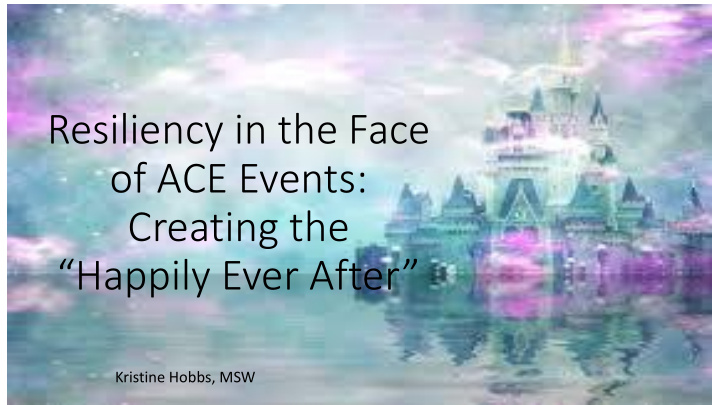



Resiliency in the Face of ACE Events: Creating the “Happily Ever After” Kristine Hobbs, MSW
Disclosure Statement Kristine Hobbs, LMSW • I have no relevant financial relationships with the manufacturers(s) of any commercial products(s) and/or provider of commercial services discussed in this CME activity. • I do not intend to discuss an unapproved/investigative use of a commercial product/device in my presentation.
Sources: • Dr. Bruce Perry - Born for Love: Why Empathy is Endangered — and Essential – https://www.youtube.com/watch?v=M6kDeBaJi0M • National Alliance of Children’s Trust & Prevention Funds – online training - http://www.ctfalliance.org/ • Larry Bendtro – Children’s Trust Conference September 2015 • https://www.starr.org/training/youth/aboutcircleofcourage • http://www.whatmakesyourfamilystrong.org/index.html • https://www.aap.org/en- us/Documents/resilience_messaging-at-the-intersections.pdf
Building on our QTIP initiatives: Dr. Ramkumar – Jan 2014
Dr. Greenhouse – January 2016 Dr. Greenhouse – January 2016
Eliciting Strengths QTIP Style: • “We’ve talked about what’s going on that’s not going well…how about what’s going right? “ Hope Health • “Tell me your favorite activity to do as a family.” CPM • “What is your favorite part about being your child's parent ?” AnMed
Strengths -- from the Child’s Viewpoint: • Is child experiencing nurturing, comfort and love? • Are child’s needs being met? • Is child getting guidance to grow and learn in a positive way? http://www.ctfalliance.org/onlinetraining.htm
Strengthening Families can refer to EITHER:
Concrete Support in Times of Need What is it: • Support and services that address a family’s need and help minimize stress caused by challenges What does it look like? • Steady income • Health insurance • Access to food • Shelter • Clothing
SEEK QTIP Monthly Call November 2015
Parenting Programs AGENCY/PROGRAM DETAILS LOCATION / CONTACT Parent Support Groups Justice Works Children and Youth Program 200 Elm St. Strengthening Families FamilyCorps Conway, SC 29526 Program Monday 5:30 Child Abuse Awareness & (843) 488-1615 Prevention Training Postpartum Support International International (PSI) Postpartum Support 800-944-4PPD Warmline (800-944-4773) National Parent Helpline Family Support Services 1-855-427-2736 M-F 7am-4pm Horry County A Father’s Place Support Services for Fathers 843-488-2923 Horry County Parents Anonymous Parent Support Group (843) 455-8540 Discipline Articles and Activities www.pediatrics.about.com Pediatric and Parenting Safe Media www.aap.org Websites Parenting Teens www.family.disney.com Education and Advocacy www.parents.com Behavior Charts
Parental Resilience What is it: • Managing stress • Functioning well What does it look like? • Faith • Humor • Supportive relationships • Problem solving • Flexibility
Social Connections What is it? • …positive relationships that provide emotional, informational, instrumental and spiritual support What does it look like? • Having people you can call when you need an ear • Having friends • Having emergency contacts for your kids*
Knowledge of Parent and Child Development • Responding effectively to manage a child’s behavior and • Prevent frustration • Notice when child’s development is atypical
Positive Reframe Negative Frame Positive Frame Bossy Good director, Natural leader Clingy Affectionate Fussy about food/clothes Specific tastes, Strong sense of self Naughty Independent, Exploring boundaries Nosey Curious, Inquisitive Not focusing Processing Various Information Spoiled Needs clear boundaries, Loved Tattletale Seeks justice
The Circle of Courage Philosophy: the Circle of Courage is a model of positive youth development described in the book Reclaiming Youth at Risk, co-authored by Larry Brendtro, Martin Brokenleg, and Steve Van Bockern. The model integrates Native American philosophies of child-rearing, the heritage of early pioneers in education and youth work, and contemporary resilience research. The Circle of Courage is based on four universal growth needs of all children: belonging, mastery, independence, and generosity.
Social and Emotional Competence of Children • Nurturing and supporting interactions that help children handle feelings • Secure attachment to caregiver • Ability for children to communicate emotions
Children’s Trust of SC: Nurturing Knowledge of Parent and Child Development
ACCESS TO HEALTHCARE Is always a strength.
H Hope E Empathy L2 Language Loyalty P3 Permission Partnership Plan
Body Language Voice https://www.mindtools.com/pages/article/Body_Language.htm
Recommend
More recommend